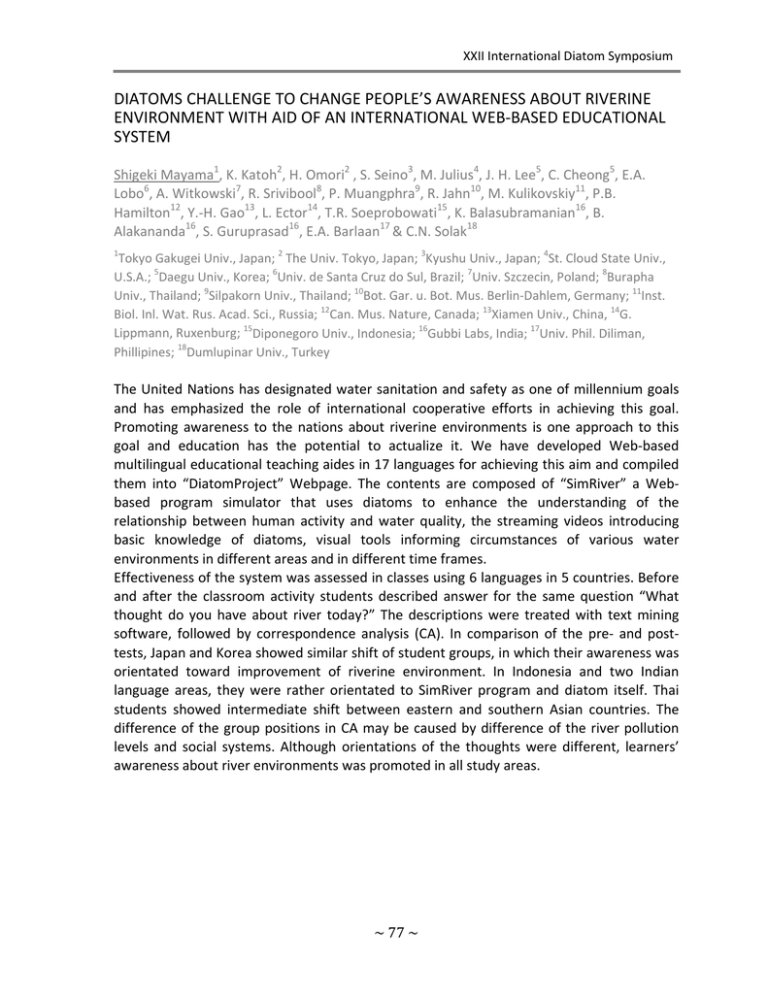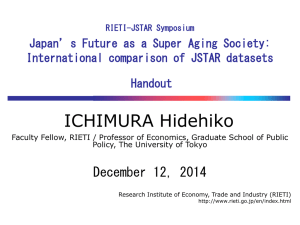DIATOMS CHALLENGE TO CHANGE PEOPLE’S AWARENESS ABOUT RIVERINE ENVIRONMENT WITH AID OF AN INTERNATIONAL WEB‐BASED EDUCATIONAL
advertisement

XXII International Diatom Symposium DIATOMS CHALLENGE TO CHANGE PEOPLE’S AWARENESS ABOUT RIVERINE ENVIRONMENT WITH AID OF AN INTERNATIONAL WEB‐BASED EDUCATIONAL SYSTEM Shigeki Mayama1, K. Katoh2, H. Omori2 , S. Seino3, M. Julius4, J. H. Lee5, C. Cheong5, E.A. Lobo6, A. Witkowski7, R. Srivibool8, P. Muangphra9, R. Jahn10, M. Kulikovskiy11, P.B. Hamilton12, Y.‐H. Gao13, L. Ector14, T.R. Soeprobowati15, K. Balasubramanian16, B. Alakananda16, S. Guruprasad16, E.A. Barlaan17 & C.N. Solak18 1 Tokyo Gakugei Univ., Japan; 2 The Univ. Tokyo, Japan; 3Kyushu Univ., Japan; 4St. Cloud State Univ., U.S.A.; 5Daegu Univ., Korea; 6Univ. de Santa Cruz do Sul, Brazil; 7Univ. Szczecin, Poland; 8Burapha Univ., Thailand; 9Silpakorn Univ., Thailand; 10Bot. Gar. u. Bot. Mus. Berlin‐Dahlem, Germany; 11Inst. Biol. Inl. Wat. Rus. Acad. Sci., Russia; 12Can. Mus. Nature, Canada; 13Xiamen Univ., China, 14G. Lippmann, Ruxenburg; 15Diponegoro Univ., Indonesia; 16Gubbi Labs, India; 17Univ. Phil. Diliman, Phillipines; 18Dumlupinar Univ., Turkey The United Nations has designated water sanitation and safety as one of millennium goals and has emphasized the role of international cooperative efforts in achieving this goal. Promoting awareness to the nations about riverine environments is one approach to this goal and education has the potential to actualize it. We have developed Web‐based multilingual educational teaching aides in 17 languages for achieving this aim and compiled them into “DiatomProject” Webpage. The contents are composed of “SimRiver” a Web‐ based program simulator that uses diatoms to enhance the understanding of the relationship between human activity and water quality, the streaming videos introducing basic knowledge of diatoms, visual tools informing circumstances of various water environments in different areas and in different time frames. Effectiveness of the system was assessed in classes using 6 languages in 5 countries. Before and after the classroom activity students described answer for the same question “What thought do you have about river today?” The descriptions were treated with text mining software, followed by correspondence analysis (CA). In comparison of the pre‐ and post‐ tests, Japan and Korea showed similar shift of student groups, in which their awareness was orientated toward improvement of riverine environment. In Indonesia and two Indian language areas, they were rather orientated to SimRiver program and diatom itself. Thai students showed intermediate shift between eastern and southern Asian countries. The difference of the group positions in CA may be caused by difference of the river pollution levels and social systems. Although orientations of the thoughts were different, learners’ awareness about river environments was promoted in all study areas. ~ 77 ~


